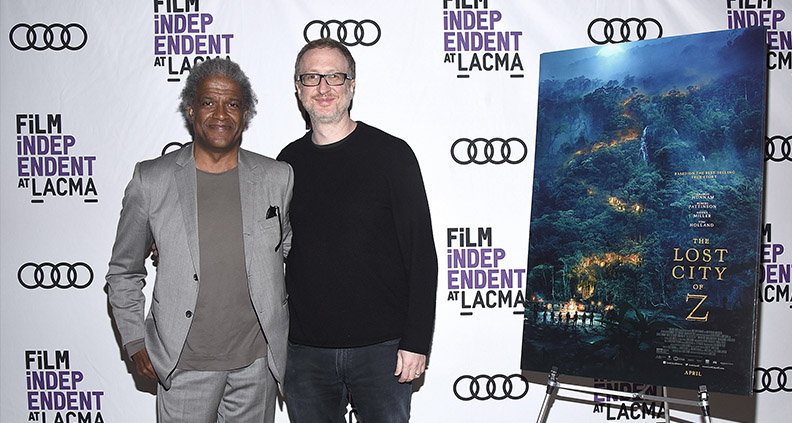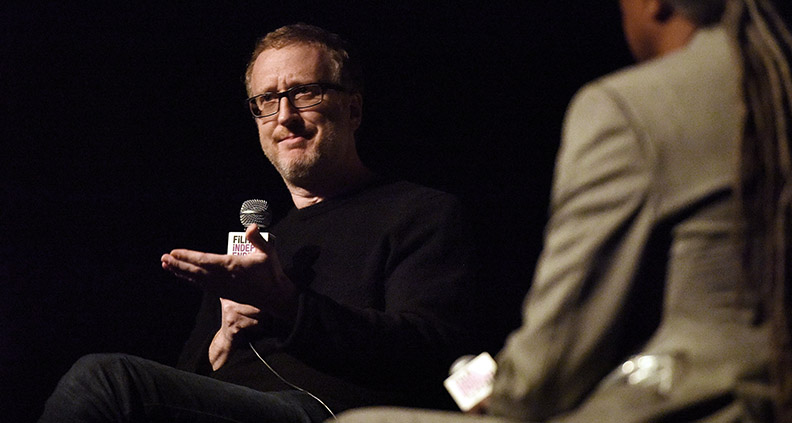The Jungle Does Not Want You To Make a Movie: James Gray on ‘The Lost City of Z’
This weekend as multiplex audiences queue up for another turbocharged dose of muscle-car escapism courtesy of Fate of the Furious, there’s yet another new release in theaters; one no less packed with globe-hopping hijinks and hardcore themes of family, lost and found. The film is James Gray’s The Lost City of Z, based on David Grann’s 2009 nonfiction account of English adventure Percy Fawcett’s early 20th-century journeys into the Amazon. The film screened at Film Independent at LACMA on April 6 followed by a lengthy Q&A with Gray—a director whose throwback vision of epic, old-school moviemaking in 2017 is truly one-of-a-kind.
SHOOTING ON LOCATION
Film Independent at LACMA curator Elvis Mitchell began the Q&A by asking Gray about the look of the film. “I decided I had to make this on film,” said Gray, a diehard celluloid fan and proponent. “I had this obsessive notion that you had to see the grain.” But unsurprisingly, shooting on location in South America on film presented a unique set of challenges.
Upon arriving on location, Gray and his team quickly realized there were no trained film loaders available locally. So they had to train a loader out of nearby Bogotá (said Gray: “He looked like Sid Vicious”), sending footage back to London daily for processing. And while things mostly worked out, the unnamed film loader’s inexperience did ultimately lead to three whole days of lost work.

Using vintage lenses dating from the 1950s and ‘60s, Gray quickly determined that “the jungle doesn’t want you to make a movie.” At one point he received a frantic phone call from the production’s secondary film lab in Tarzana, alerting him that there was literal vegetation growing the cameras, visible in frame.
Mitchell asked why Gray, a filmmaker best known for his thoughtful portrayals of big city New York living (We Own the Night, Two Lovers, The Immigrant) decided to take on the tale of an Englishman’s exploration of the Amazon, with pit-stops in Ireland and the French battlefields of World War I. “I know, there’s noting in my work to suggest I could ever leave Brighton Beach,” laughed Gray.
CHARLIE HUNNAM
Gray was introduced to the project through Brad Pitt, whose Plan B production company had optioned Gann’s book. Originally, Pitt was set to star as Percy. When that didn’t work out, Benedict Cumberbatch was on tap. But ultimately the role went to Sons of Anarchy star Charlie Hunnam, who recognized the opportunity to level up in terms of the material he was being offered in Hollywood.
To properly convey the toll of the Fawcett team’s excursions into the jungle, Hunnam and co-star Robert Pattinson each lost around 40 pounds—in only eight weeks. “They were really proud of themselves,” said Gray, who noted that shedding weight became something of a competition between the two. “I didn’t want to tell them you can’t really tell [under all of the film’s heavy, period-appropriate wardrobe].”
CONTEXT AND RESOURCES
Moving on to Z’s theme of white European imperialism, Gray confessed that the production had to soften some of the IRL Fawcett’s typical-for-its-time racism—admitting that while the historical Fawcett’s views of indigenous culture was extremely progressive for its time, much of the explorers actual language and attitudes are nevertheless highly problematic by 21st-century standards. “Unfortunately you can’t separate a person from their era,” said Gray. “You cannot judge people outside of their context.”

Mitchell then asked about difficulties Gray faced in trying to create the sort of film Hollywood has all but abandoned: namely, an epic period adventure drama, shot on location, with largely practical effects. “I can’t match David Lean or Francis Coppola in terms of resources,” the director claimed, citing Z’s incredibly truncated 48-day shooting schedule. “I know I can’t top having the entire Philippian air force [as Coppola did when shooting Apocalypse Now]. What could I bring to it?”
CATASTROPHES AND HIERARCHIES
Wrapping up, Mitchell asked Gray if he felt any sort of affinity with Fawcett’s quixotic adventuring. Said Gray, “Being a director, there’s an obsession. And it usually ends in catastrophe.” He added, “I found something very personal about it. I was interested in making a movie that explored hierarchies.” Part of Gray’s interest was in examining how World War I “laid waste” to notions of European superiority around the globe, as well as how that decline occurred in tandem with the rise of women’s right—embodied in the film by Percy’s steadfast wife Nina, played by Sienna Miller.
Mitchell asked the deliberately retro-leaning Gray if his work represented “the end of an era.” For his part, Gray pointed out that, despite everything, his films keep getting made.
The Lost City of Z opens in theaters this weekend. To learn more about upcoming Film Independent at LACMA events, click here. Not a Member of Film Independent yet? Become one today.